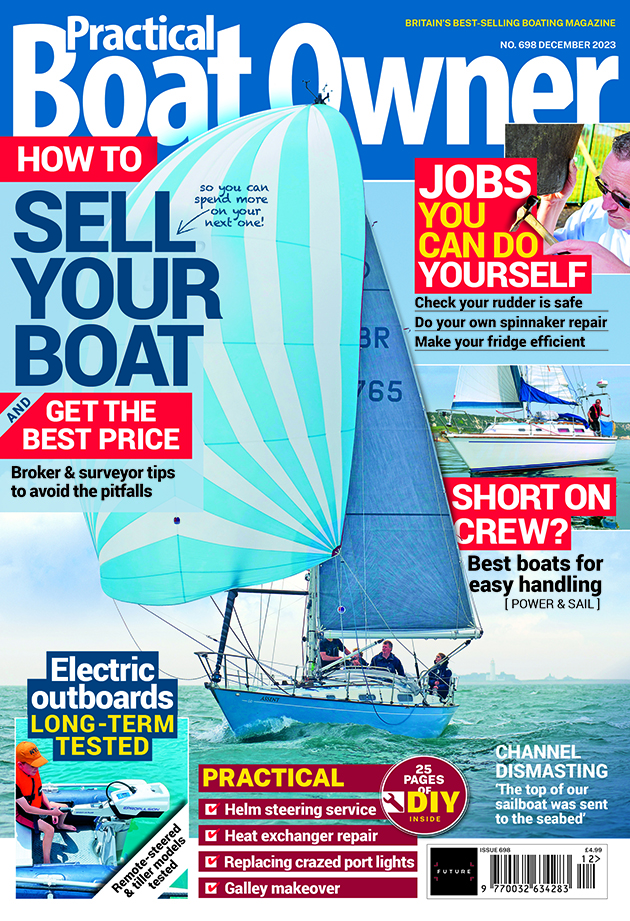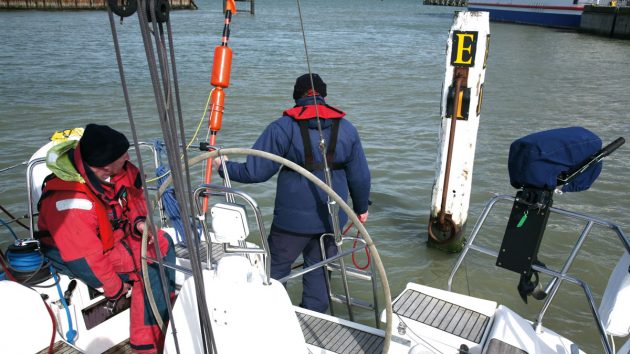Picking up a pile mooring can be a challenge – especially in a tidal harbour. David Harding explains how it’s done
Pile moorings are less common than they used to be, but there are still plenty to be found –even in busy harbours.
As you approach a pile, you will see a vertical metal bar on the upstream and/or downstream side.
Around the bar is a metal ring, and it’s through this ring that you ideally loop your mooring line.

As the bow might make contact with the upstream mooring pile, it’s best to lash a couple of fenders together lengthwise from the pulpit as far forward as possible. Credit: David Harding
This ensures that your line will slide up and down without chafing as the tide rises and falls.
In practice, because the ring will be sitting at the bottom of the bar and probably difficult to reach from the deck of a yacht, it’s normally easier to loop your line straight through the bar to start with and then re-reeve it from a dinghy later.

This is how the rope is prepared on the cockpit sole, in a figure-of-eight, with the coils on top ready to run. It’s less likely to tangle than a conventional circular coil. Credit: David Harding
As in any mooring situation, it’s essential to plan your approach according to the wind and tide.
Any tide will almost certainly be the dominant factor.

The stern-line is looped through the bar on the downstream pile. It’s awkward to pass it through the ring, which is sitting at the bottom of the bar; this can be sorted out later. Credit: David Harding
You have to be organised, with lines, fenders and people in the right places. If the distance between the piles is substantially greater than the length of the boat, you will also need some long lines that are ready to run rapidly.
For this exercise, we were with Tony Edwards, of Powersail Training, and his crew of Yachtmaster Coastal students.
The tide was flooding and the north-easterly wind, at a slight angle to the current, was gusting to around 15 knots in the harbour.
Where chosen piles were, the wind was swirling unpredictably.
Once Tony had run through the basic procedure, we motored gently past the piles for a close look and to assess the wind and current.
It’s often hard to judge what’s happening from some distance away. Then we got the lines and fenders ready and did it for real.
Picking up a pile mooring: heading in bow first

1. Our plan was to approach from down-tide, as you normally would with a swinging mooring

2. We passed close to the downstream pile to allow the crew at the stern to loop the stern-line through the metal bar attached to the pile.

One crewmember then keeps hold of the end of the stern-line as the boat moves ahead, while another makes sure there’s plenty of slack from the coil in the cockpit. Credit: David Harding

3. Going ahead gently, we then aimed the bow towards what we had expected to be the windward side of the upstream pile, so the wind could blow the bow towards it. The crew at the bow could fend off and loop the bow-line through the metal bar.

With the bow manoeuvred close to the upstream pile, we pass the bow-line through the bar. Note the roaming fender to protect the gunwale. Credit: David Harding

Wind eddies in the lee of the shore and the ferry mean the bow doesn’t get blown on to the pile, so Tony does a few shunts forward and aft to bring the bow close. Credit: David Harding

4 After that we shortened the stern-line as we eased the bow-line to position the boat centrally.

Now the stern-line can be shortened as the bow-line is eased to centre the boat between the mooring piles. Credit: David Harding
Getting off was easy: we simply released the stern-line, bringing it back aboard smartly to keep it out of the water and away from the propeller, then slipped the bow-line
Picking up a pile mooring: heading in stern first
A bow-first approach is the established technique, but in a strong wind or tide it can – depending on your boat’s handling qualities – be easier to approach in astern.
Once you’ve secured the stern line, however, you still have to get the bow on to the other pile mooring: unless the wind and tide are directly in line with the piles, the boat won’t lie with the bow pointing directly towards the other pile when the stern-line takes the weight.
Continues below…
Swinging mooring setup: What I learned from trying a cheaper mooring option
After almost two decades of being marina berthed and concerned with the ever-increasing mooring fees, myself, and my partner, Brian,…
14 tips for single handed anchoring
Ben Meakins tries out some methods for dropping and recovering the anchor for singlehanded sailors in crowded anchorages
Best boat rope – the right rope for mooring lines, halyards and sheets
At this time of year we often start to put into place plans for upgrading our boats for the new…
This is why it’s important to take the stern line from the windward and/or upstream quarter.
Then, once the line is through the pile and surged around a cleat, you can power against it on full lock to swing the bow towards the downstream pile while easing the line out gently.
If you have the stern-line secured to the wrong quarter, the boat will swing the other way.

1. Tony reverses to the upstream pile.
A crew-member is ready to loop the stern-line through from a cleat on the windward quarter.

2. The line is passed through the pile and initially left slack, allowing the boat to drift towards the downstream pile.

3. Wind and tide mean that the bow isn’t pointing to the downstream pile, so we need some engine power and starboard lock.

4. The bow is approaching the downstream pile and the crew is ready with the fender and bow-line.

5. Now all that’s needed is to pass the bow-line through the pile and adjust the lines to put the boat in the middle.
Enjoyed reading this article? 
A subscription to Practical Boat Owner magazine costs around 40% less than the cover price.
Print and digital editions are available through Magazines Direct – where you can also find the latest deals.
PBO is packed with information to help you get the most from boat ownership – whether sail or power.
-
-
-
- Take your DIY skills to the next level with trusted advice on boat maintenance and repairs
- Impartial in-depth gear reviews
- Practical cruising tips for making the most of your time afloat
-
-







